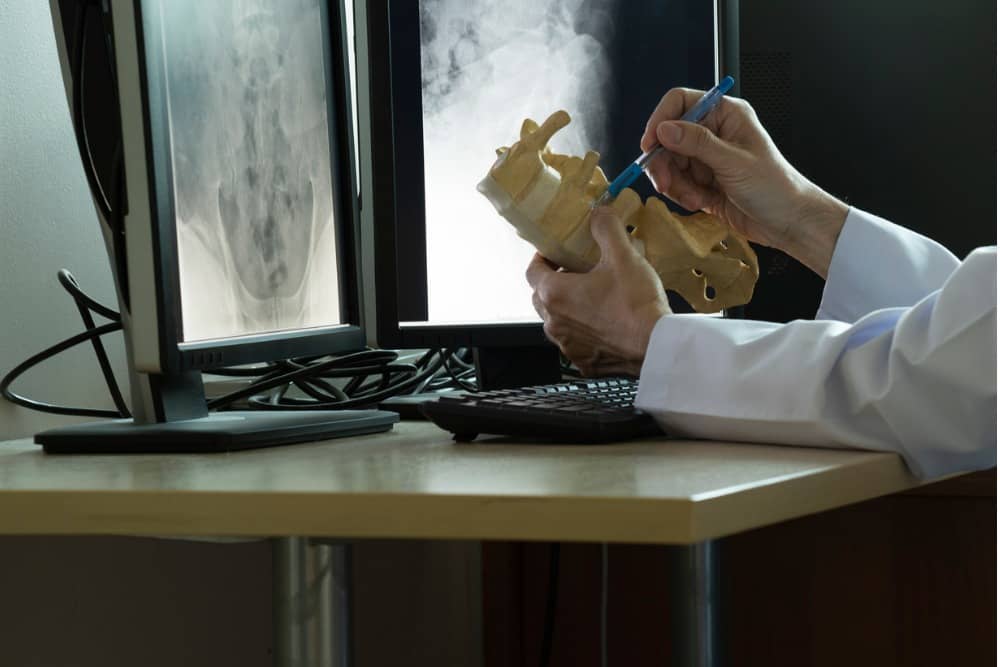
What causes bone spurs?
Bone spurs are small, pointed or rounded outgrowths of bone that can develop wherever inflammation occurs which is usually near joints. Bone spurs along the spine are common among patients who have degenerative disc disease or osteoarthritis. Some bone spurs may never cause any pain, but if a bone spur compresses a nerve, pain is inevitable.
Bone spurs are formed by a miscommunication in the body that fires up the body’s histamines to fight a perceived injury to a joint. The ligaments of a facet joint are typical vectors for osteoarthritis and bone spurs. The small ligaments of the joints become inflamed with synovitis. The body’s immune response mistakenly commands the cells that form bone deposits to create bone spurs.
How are bone spurs diagnosed?
Bone spurs are best diagnosed using X-rays, myelograms, plus CT and MRI scans. Ultrasound imaging is also an excellent tool for finding the bony deposits.
Location is everything for bone spurs. For example, bone spurs that form near your spinal cord (spinal stenosis) or in your foramina (foraminal stenosis) will generate a specific type of pain if a nerve root that serves your arms or legs is compressed. Bone spurs in your facet joints will often compress local nerve cells producing pain near the vertebra where they are located making it easier to identify their source.
What is the treatment for bone spurs?
Once your doctor has confirmed that your pain is caused by bone spurs, he or she will probably assume that some type of osteoarthritis is afoot and suggest anti-inflammatory medications. This will curb your body’s faulty immune response that is causing the production of the bone spurs. It should also reduce the swelling along the ligaments and joints which may be causing pain. Anti-inflammatories may even help if you have stenosis by reducing swelling along your nerve channels.
Over-the-counter medications are available, but they are not all the same. For example, acetaminophen (Tylenol) will reduce pain but not reduce inflammation. The nonsteroidal anti-inflammatory drugs (NSAIDS) such as aspirin, naproxen and ibuprofen will treat pain and inflammation.
For intense pain, some doctors may prescribe opioid-based pain relievers and muscle relaxants. Dr. Melamed’s practice is opioid-free. He may suggest holistic alternatives such as acupuncture, Tai-Chi, yoga, Pilates, and structured, low-impact, exercise programs. Epidural corticosteroid injections may also be components of Dr. Melamed’s treatment plan to reduce pain caused by bone spurs.
Since bone spurs are a sign of inflammation, Dr. Melamed may recommend lifestyle changes such as a diet that includes spices and vegetables that naturally counteract inflammation. If you are a smoker, Dr. Melamed can help you curb a habit that has been shown to impede spine recovery after surgeries.
For those patients who do not respond to non-surgical treatment after a few months, Dr. Melamed may request additional imaging tests. All appropriate surgical options will be reviewed carefully to find the most appropriate microdecompression treatment for your bone spurs. All of Dr. Melamed surgeries are opioid-free which reduces the risk of drug dependency in the future.
Minimally-Invasive Lumbar Microdecompression
This minimally invasive procedure is used to remove overgrown vertebral bone and soft tissue to relieve the compression of nerve roots in the lumbar spine. It is performed through a small incision on the back.
Find out if bone spurs are causing your back pain.
Click on the “Make An Appointment” button at the top of this page, or call Dr. Melamed’s office for more information. Call us at 310-928-2769.



